
Taipei, officially Taipei City, is the de-facto capital and a special municipality of Taiwan. Located in Northern Taiwan, Taipei City is an enclave of the municipality of New Taipei City that sits about 25 km (16 mi) southwest of the northern port city of Keelung. Most of the city rests on the Taipei Basin, an ancient lakebed. The basin is bounded by the relatively narrow valleys of the Keelung and Xindian rivers, which join to form the Tamsui River along the city's western border.
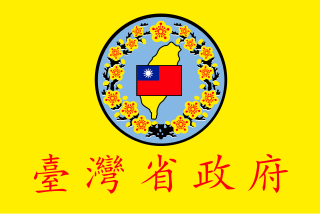
Taiwan Province is a nominal province of the Republic of China without administrative function. Its administrative powers have been transferred to the central and county governments.
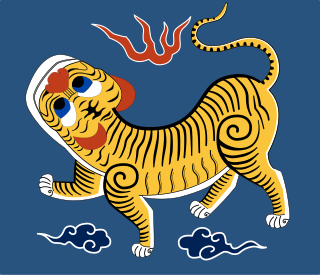
The Republic of Formosa was a short-lived republic that existed on the island of Taiwan in 1895 between the formal cession of Taiwan by the Qing dynasty of China to the Empire of Japan by the Treaty of Shimonoseki and its being taken over by Japanese troops. The Republic was proclaimed on 23 May 1895 and extinguished on 21 October, when the Republican capital Tainan was taken over by the Japanese. Though sometimes claimed as the first Asian republic to have been proclaimed, it was predated by the Lanfang Republic in Borneo, established in 1777, as well as by the Republic of Ezo in Japan, established in 1869.
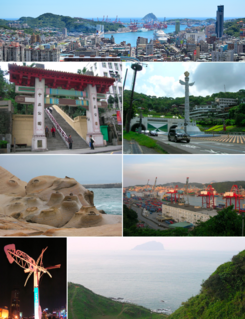
Keelung, officially known as Keelung City, is a major port city situated in the northeastern part of Taiwan. It borders New Taipei with which it forms the Taipei–Keelung metropolitan area, along with Taipei itself. Nicknamed the Rainy Port for its frequent rain and maritime role, the city is Taiwan's second largest seaport.

New Taipei City is a special municipality and the most populous city in Taiwan. Located in northern Taiwan, the city includes a substantial stretch of the island's northern coastline and surrounds the Taipei Basin, making it the second largest special municipality by area, behind Kaohsiung. New Taipei City is bordered by Keelung to the northeast, Yilan County to the southeast, and Taoyuan to the southwest. It completely surrounds Taipei. Banqiao District is its municipal seat and biggest commercial area. Until 2010, the area that roughly corresponds to the present New Taipei City was known as Taipei County.
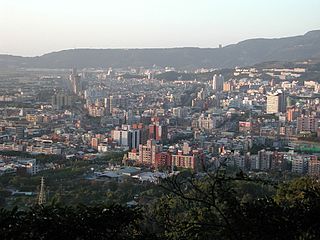
Shilin District is a district of Taipei. It is home to a large foreign population, mainly concentrated in the Tianmu area. It has long been a top choice for expatriates from Europe, US, Canada, Southeast Asia and Japan to live, run businesses, and establish embassies and offices due mainly to the natural environment—sitting at the foot of Yangmingshan—and because the international schools are all located here. The central command of the Republic of China Navy is located in Shilin.

Wanhua District, known in Taiwanese Hokkien as Báng-kah khu and historically as "Monga" or "Monka", is a district in Taipei, Taiwan. It is Taipei's oldest district. The district is home to historic buildings such as the Bangka Lungshan Temple, an iconic historic temple, and the Red House Theater, the first and largest teahouse and playhouse in Taiwan. Taipei's oldest, but decaying, garment district is also here.

Datong District or Tatung is a district of Taipei City, Taiwan. It is located between the Taipei Metro Red Line and eastern shore of the Tamsui River, and between Civic Boulevard and the Sun Yat-sen Freeway. The southern part of this area used to be the site of Twatutia, one of the first settlements in what is now Taipei and for a time the area's commercial center. Taipei's commercial center has since shifted south east to Zhongzheng, Da'an and Xinyi, and Datong is far less important economically. One of the last vestiges of Twatutia's commercial importance disappeared with the closing of the Chien-Cheng Circle in 2006. The north was the site of the village of Daronpon.
Twatutia, is an area in Datong District, Taipei, Taiwan. It was also known as Daitōtei during Japanese rule, and Tataocheng or Dadaocheng (Mandarin) during the Kuomintang era.
Taiwan was under Japanese rule after the First Sino-Japanese War, as per the Treaty of Shimonoseki of 1895. There were still several changes until the Japanese political system was adopted in 1920.

Taihoku Prefecture was an administrative division of Taiwan created in 1920, during Japanese rule. The prefecture consisted of modern-day Keelung, New Taipei City, Taipei and Yilan County. Its government office, which is now occupied by the Control Yuan of Taiwan, was in Taihoku City.

The Japanese invasion of Taiwan was a conflict between the Empire of Japan and the armed forces of the short-lived Republic of Formosa following the Qing Dynasty's cession of Taiwan to Japan in April 1895 at the end of the First Sino-Japanese War. The Japanese sought to take control of their new possession, while the Republican forces fought to resist Japanese occupation. The Japanese landed near Keelung on the northern coast of Taiwan on 29 May 1895, and in a five-month campaign swept southwards to Tainan. Although their advance was slowed by guerrilla activity, the Japanese defeated the Formosan forces whenever they attempted to make a stand. The Japanese victory at Baguashan on 27 August, the largest battle ever fought on Taiwanese soil, doomed the Formosan resistance to an early defeat. The fall of Tainan on 21 October ended organised resistance to Japanese occupation, and inaugurated five decades of Japanese rule in Taiwan.

Taiwan under Qing rule refers to the rule of the Qing dynasty over Formosa from 1683 to 1895. The Qing court sent an army led by general Shi Lang and annexed Taiwan in 1683. It was governed as Taiwan Prefecture of Fokien Province (Fujian) until the declaration of Fokien-Taiwan Province in 1887. Qing rule over Taiwan ended when Taiwan was ceded to Japan by the Treaty of Shimonoseki in 1895. There were more than a hundred rebellions during the Qing period. The frequency of rebellions, riots, and civil strife in Qing Taiwan led to this period being referred to by historians as “Every three years an uprising, every five years a rebellion.”
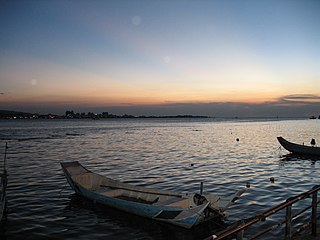
Tamsui District is a sea-side district in New Taipei, Taiwan, Republic of China. It is named after the Tamsui River; the name means "fresh water". The town is popular as a site for viewing the sun setting into the Taiwan Strait. Though modest in size, it has a large role in Taiwanese culture.
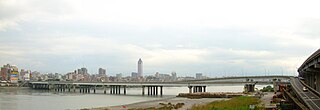
Taipei Bridge is a motor-vehicle bridge across the Tamsui River connecting Taipei with Sanchong District, New Taipei City in Taiwan. A central span carries automobile and some motorcycle traffic while narrower spans on either side carry most motorcycle traffic along with bicycle pedestrian traffic. The central bridge is 481.6 meters in length.
Taiwan Prefecture or Taiwanfu was a prefecture of Taiwan during the Qing dynasty. The prefecture was established by the Qing dynasty government in 1684, after the island "became an integral part of the Chinese Empire" in 1683. The Taiwan Prefecture Gazetteer documented it as part of Fujian Province. The Taiwan Prefecture Gazetteer was completed by Gao Gonggan in 1695, the 34th year of the reign of the Kangxi Emperor.
The history of Hsinchu extends over more than 400 years, making it one of the oldest cities in northern Taiwan.
Taipeh Prefecture was a Qing dynasty prefecture created from the northern part of Taiwan Prefecture, Qing-era Taiwan in 1875, while the island was still part of Fujian Province. It consisted of a region surrounding modern-day Taipei in northern Taiwan, including modern-day Hsinchu, Hsinchu County, Taoyuan City, New Taipei City, Taipei, Keelung, and Yilan County. The reorganization started after Imperial Commissioner Shen Pao-chen demanded that another prefecture be added in Taiwan to revamp the administrative organization of the northern area of the island. The walls of the prefecture capital were completed in 1884.
Tainan Prefecture was a prefecture of Taiwan under Qing rule. The prefecture was established by the Qing dynasty government in 1887, when Fokien-Taiwan Province was established. The prefecture included the districts/counties of Anping, Kagi, Fengshan, and Hengchun, and the sub-prefecture of Penghu.
The architecture of Taiwan can be traced back to stilt housing of the aborigines in prehistoric times; to the building of fortresses and churches in the north and south used to colonize and convert the inhabitants during the Dutch and Spanish period; the Tungning period when Taiwan was a base of anti-Qing sentiment and Minnan-style architecture was introduced; in Qing dynasty period, a mix of Chinese and Western architecture appeared and artillery battery flourished during Qing's Self-Strengthening Movement; During the Japanese rule of Taiwan, the Minnan, Japanese and Western culture were main influencers in architectural designs and saw the introduction and use of reinforced concrete. Due to excessive Westernization as a colony, after the retrocession of Taiwan to the Republic of China in 1945 from Japan at the end of World War II, Chinese classical style became popular and entered into international mainstream as a postmodern design style. Today, Taiwanese architecture has undergone much diversification, every style of architecture can be seen.
















